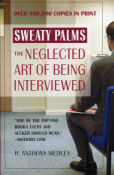| What REALLY goes on in a job interview? Find out in the new revision of "Sweaty Palms: The Neglected Art of Being Interviewed" (Warner Books) by Tony Medley, updated for the world of the Internet . Over 500,000 copies in print and the only book on the job interview written by an experienced interviewer, one who has conducted thousands of interviews. This is the truth, not the ivory tower speculations of those who write but have no actual experience. "One of the top five books every job seeker should read," says Hotjobs.com. | |
|
Poseidon (7/10) by Tony Medley The movie opens with a long tracking shot of Dylan Johns (Josh Lucas) jogging around the deck of the huge ship. In fact, as real as the ship looks, nobody ever saw it. It was all computer generated and Lucas was actually jogging around a reservoir. When you realize how this was done and that there is no ship there, this opening shot is worth the price of admission by itself. Unless you live on Mars, you should know the story. A huge wave turns the giant ship 180 degrees over, so up is down and down is up. A few intrepid people follow Johns as he leaves the apparent safety of the huge ballroom to try to find a way up and out. These include a gay Richard Nelson (Richard Dreyfuss) who is suicidal because he has just been jilted, Robert Ramsey (Kurt Russell), his daughter Jennifer (Emmy Rossum) and her boy friend, Christian (Mike Vogel), Maggie James (Jacinda Barrett) and her son Conor (Jimmy Bennett), Elena (Mia Maestro) and her boy friend, Valentin (Freddy Rodgriquez) a waiter who smuggled her aboard and is taken along because he knows the layout of the ship, and Lucky Larry (Kevin Dillon), a drunken, loudmouthed gambler. Director Wolfgang Petersen does a superb job of making this remake his own without pandering to the original. In fact, kudos to him for bringing it in at 98 minutes, 20 minutes shorter than the original. Not only that, but it was finished on schedule and under budget. “Most movies are shot in 3 months or less,” says Australian actress Barrett, “but this one took 5 months. Most movies use three cameras. This movie used ten.” There were many injuries during shooting. An electrician was electrocuted near the start of the shoot in a Jacuzzi that was placed near electrical outlets. The purpose of the Jacuzzi was to keep the actors warm when they were out of the tanks, where they spent a lot of their time in water. Lucas tore two tendons in his hand and had two surgeries during the shoot. Kurt Russell injured his eye, got the flu, and finally got pneumonia. Jimmy Bennett choked and Russell had to perform the Heimlich Maneuver to save his life. These are just a few of the injuries suffered during a shoot that Barrett describes as “constantly relentless.” Unfortunately, they are almost undone by a script (Mark Protosevitch) with dialogue so weak that sometimes the actors had to improvise. In one scene Conor is trapped in a rapidly filling compartment and on the other side of a screen, in another compartment, is mother, Maggie. “When we got on the set we realized that the dialogue just didn’t work,” says Barrett, “so we improvised the entire scene. In fact, when Conor sinks out of sight it was unplanned. Something had pulled him down. My scream was real!” It was so grueling that each actor had a water safety person close by on every scene. Some of the major deficiencies of the script were not cured by actors improvising. Shortly after the disastrous wave hits the ship, Elena turns to Nelson. The ship is completely turned over. There are dead bodies all over the place. Water is rushing in. Fires are breaking out. Despite all this evidence, Elena asks, “How bad is it?” How bad is it? Open you eyes, woman! What do you think? But Nelson is up to the task. “It’s bad,” he replies. As they are fighting their way through floods and fires and over huge, deep chasms with electric charges flashing all around, Elena says to Jennifer, as if they are sipping tea at the Plaza, “I feel like I know your Dad.” Jennifer smiles and says, “He was mayor of New York for awhile.” “Cool,” says Elena. Clearly, much more improvisation was needed. For me, however, the rest of the film, the way it is directed, the acting, the special effects, and the stunts, overcome the script. As they are climbing through the huge ship they get in some tight spaces. “These were as claustrophobic as they appear,” says Barrett. “The passageways were as tight as you see on the screen and once you got in they would shut them up and someone would stand on the hatch so you couldn’t get out. It was hot and sweaty in there with nothing to hold on to. If you had any claustrophobia, it was very difficult.” Cinematographer John Seale starts out the film with vibrant, fully saturated colors showing the joy and gaiety of the passengers on a fun cruise. However, after the wave hits, he slowly drains the color out of the film so that when it ends, it is much more monochromatic. Petersen does a wonderful job of keeping up the pace of the film. The special effects that pop all around the cast as they are trying to climb up from the top of the ship to the bottom to get out are eye-popping. As exceptional as the special effects are, so are the stunts. There is no point at which the action lags. If you can willingly suspend your disbelief and accept the fact that this is a movie, so it is going to be full of plot holes, it’s fun, held my interest, and ends when it should end. May 10, 2006 |
|
|
|
|
